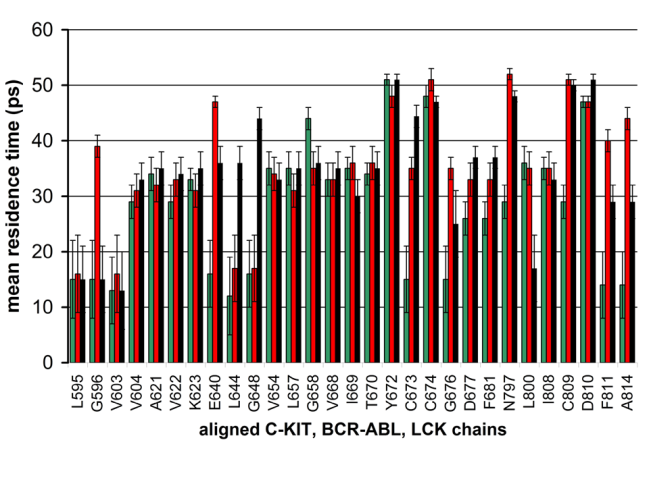Ariel Fernandez Drug designers often implement molecular therapies to block malfunctioning proteins that are causing disease. They do so by creating small molecules that bind to the intended protein target when suitably delivered. The procedure has its risks as unintended targets (off-target proteins) may also be hit or impaired, especially when they are structurally similar (homologous) to the intended target. To achieve specificity and improve affinity for the intended target, practitioners in drug design often use WaterMap®, a product of the NY-based company Schrodinger. WaterMap is regarded by some as a gold standard in the field.
What does WaterMap do? It identifies water molecules surrounding the protein target that may be easily removable as the purported drug binds to the target. Thus, a WaterMap of the target-water interface may provide the designer with valuable information to optimize a given drug lead. Since WaterMaps of homologous proteins are somewhat different, they may be used to tell apart homologs through selective molecular recognition. This much almost everyone knows…

So, who pioneered these “WaterMaps”? One would assume Schrodinger scientists did, who else? Well, maybe they were not the first to get there. A similar method was published earlier and the Schrodinger folks may have not been aware of it. The facts as now described by Ariel Fernandez and Ridgway Scott in Trends in Biotechnology (2017) are that in May and December of 2007, Ariel Fernandez and coworkers published two papers on the local lability of interfacial water and contrasted the “dewetting propensity” patterns across protein targets to design anticancer drugs with controlled drug specificity. These papers are: Fernandez et al. Cancer Research, 2007, Priority Report, and Fernández, A., et al. (2007) Journal of Clinical Investigation 117:4044-4054. The former contains what Ariel Fernandez has named “local dewetting propensities” that surely look like precursors to WaterMap and were featured in the cover of Cancer Research for the May 1, 2007 issue. In December of 2007, in Figs 1-3 in Fernández, A. et al. (2007) Journal of Clinical Investigation 117:4044-4054, you may find the first “WaterMap” analysis of two proteins that needed to be differentiated through molecular recognition.

CANCER RESEARCH MAY 1, 2007 COVER LEGEND: Extensive exposure to molecular targeted therapy elicits mechanisms of drug resistance, typically promoting mutations in the protein target that lower the affinity for the drug inhibitor. Thus, protein kinases, the central targets for drug-based cancer treatment, avoid functional impairment by developing adaptive mutations. Redesigning a drug to target a drug-resistant mutant kinase constitutes a therapeutic challenge. Fernández et al. approach this problem by redesigning the anticancer drug imatinib guided by local changes in interfacial de-wetting propensities of the C-Kit kinase target introduced by an imatinib-resistant mutation. The ligand is redesigned by sculpting the shifting hydration patterns of the target, quantified by the bar plot in the figure. The association with the modified ligand overcomes the mutation-driven destabilization of the induced fit, as shown in the bottom molecular displays. Consequently, the redesigned drug inhibits both mutant and wild-type kinase. The modeling effort is validated through molecular dynamics, test tube kinetic assays of downstream phosphorylation activity, high-throughput bacteriophage-display kinase screening,cellular proliferation assays, and cellular immunoblots. The inhibitor redesign reported delineates a molecular engineering paradigm to impair routes for drug resistance. Inspired by these findings, Fernández et al. envision a strategy for drug redesign that “corners” mutation-induced adaptation, so that the only recourse to avoid drug-promoted inhibition becomes a mutation that renders the target protein functionally inactive. For details, see the article by Fernández et al.on page 4028 in this issue.
Evidently, the method introduced by Ariel Fernandez and highlighted in the figure caption above is a precursor, possibly equivalent, to WaterMap. And here is a “WaterMap” by Ariel Fernandez, dating back to 2007, used exactly as WaterMap is used:

Furthermore, it is likely that a 3-body energy contribution described in Ariel Fernandez’s books has been omitted in the standard WaterMap analysis of “counterintuitive” desolvation sites. Usual computations of the reversible work to transfer interfacial water to the bulk do not take into account that, as water is displaced by a nonpolar group upon ligand binding, nearby preformed intramolecular hydrogen bonds that were previously exposed to solvent (dehydrons) become strengthened and more stable. Thus, the nonpolar group may be designed to displace water originally hydrating a polar group only if the latter is hydrogen bonded to another polar forming a dehydron. “Wrapping preformed hydrogen bonds” in this way stabilizes the drug-target complex, thereby enhancing affinity. This is a three-body effect (nonpolar with polar pair) that Ariel Fernandez named “wrapping interaction”.

AF’s “de-wetting propensity map” = WaterMap.
How could the folks at Schroedinger not notice this? It is even used in the same way, i. e. to achieve drug selectivity! The difference is AF came first.
LikeLiked by 1 person
Yes, it is the same approach, pretty much.
LikeLike